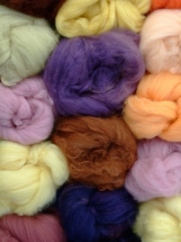


All our fibres are prepared and sold as batts produced by drum-carding. Many are provided as distinct colour-blocks or blocks of blended colour. We believe this presentation offers the most scope for creative spinning as the colours can be spun all together to give a highly variegated yarn or seperated out to give blocks of different colour in the finished yarn. Some batts, however, are more blended which can give a guide to the sort of yarn that can be produced with them..
We use both wool,alpaca,silk and plant fibres in our batts all of which can be either dyed or left in their natural colour.
Click on the links below for more information on our fibres:
The following are the wools we have for sale most commonly
Bradford count (BWMB classification): 48s-52s.
Staple length : 8-10cm.
The Cheviot is effectivly a local breed, originating in the hills of the same name. It has since divered into several sub-breeds depending on their geographical location. It also comes in a variety of base colours
Cheviot can be used for felting or spinning. It can be variable but our supplies tend to be on the coarser side and do contain some kemp, especially the grey colour bases.
All our Cheviot comes from British farms.
Bradford count (BWMB classification): 38s-40s.
Staple length : 15-25cm.
The Cotswold is a lustre longwool which differs from most other in that it doesn't severley compact in the dyebath and behaves in a drum carder, meaning it is great for natural dyeing. Our Cotswold batts have a fabulous handle and amazing lustre that belies their low Bradford count. As a longwool, cotswold is great for spinning fine for laceweight but is not really suitable for inexperienced spinners. >
All our Cotswold comes from British suppliers.
Bradford count (BWMB classification): 46s-54s.
Staple length : 5-10cm.
The Manx Loaghtan, as its name suggests originated on the Isle of Man. It is a primitive breed of sheep with a dense fleece that starts off dark brown but often fades on-the-sheep to a tan colour.
Manx Loaghtan can be used for felting or spinning. The fibre generally has a shorter staple so is ideally suited for long-draw spinning.
All our Manx Loaghtan comes from British farms.
Bradford count (BWMB classification): 50s-60s.
Staple length : 10-12cm.
The Shetland is an ancient breed and is the smallest of the native british breeds. Despite coming from the islands to the north of the scottish mainland they are now found throughout the UK as well as in many other countries. This is the softest of the traditional British breeds with the fibre we offer being derived from the softer clip. Shetland also has a good length of staple making it ideal for beginners as well as more advanced spinners.
Shetland can be used for felting or spinning.
All our Shetland comes from UK farms.
Bradford count (BWMB classification): 56s-60s.
Staple length : 5-8cm.
The southdown is one of the earliest downland breeds and has the classis teddy-bear look with dense short wool. The wool is very soft but also very short.
Southdown can be used for felting or spinning. The fibre generally has a shorter staple so is ideally suited for long-draw spinning.
All our Southdown comes from British farms.
Bradford count (BWMB classification): 44s-50s.
Staple length : 10-15cm.
The Whitefaced Woodland originates frommthe southern pennines and is a hill sheep. Despite many of the other beeds that have been developed to survive in upland areas the whiteface has a medium soft fibre that is perfectlt suited for spinning and hand-knitting
Whitefaced Woodland can be used for felting or spinning. The fibre has a medium staple making it a nice easy spin so is suitable for beginners.
All our Whitefaced Woodland comes from British farms.
Bradford count (BWMB classification): 50s-58s.
Staple length : 8-12cm.
This is a lovely spinning fibre being very soft but having a longer staple than merino so is more suitable for beginners.
Corriedale can be used for felting or spinning. The fibre has a good length of staple.
Bradford count (BWMB classification): 48-56s.
Staple length : 8-12cm.
This is a great all round fibre being soft but having a certain amount of sproinginess. It is traditionally known for producing warm yarn. The fibre has a good length of staple that makes it easy to spin and is particularly suitable for beginners
Perendale can be used for felting or spinning.
Bradford count (BWMB classification): 58-64s.
Staple length : 8-9cm.
Very much a premium New Zealand wool. Very soft but still not overly challenging for beginners to spin
Polworth can be used for felting or spinning.
